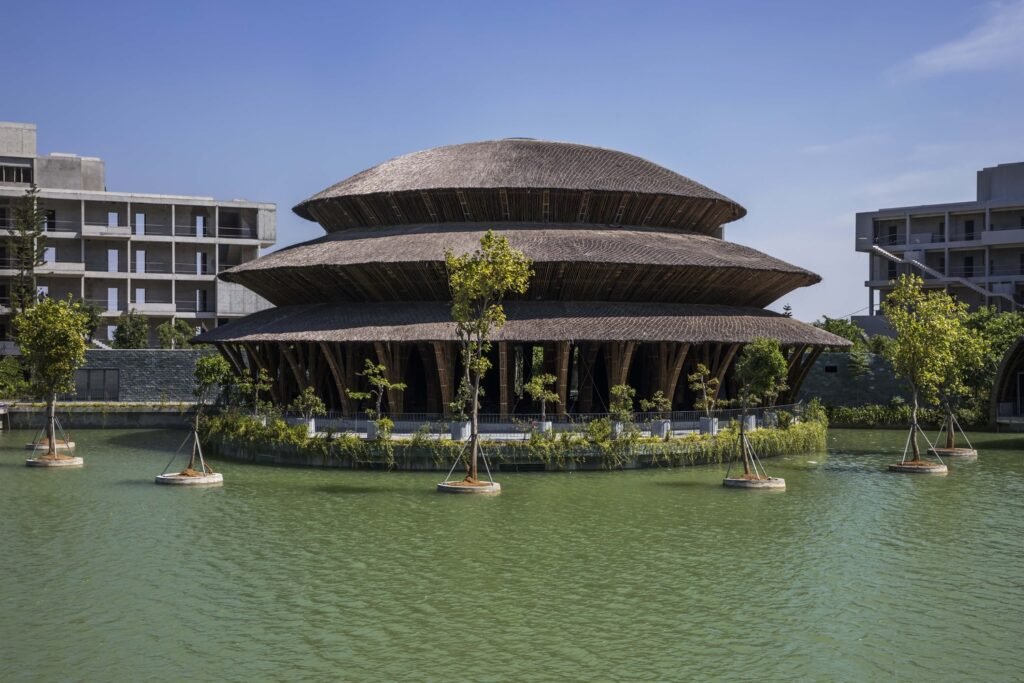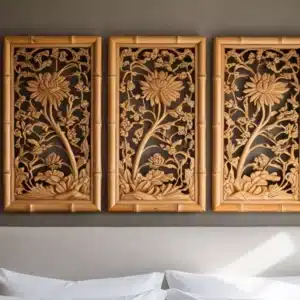Bamboo, a lightweight, sturdy, and plentiful material, stands as one of the most environmentally friendly options for construction globally, rendering buildings built from bamboo among the utmost sustainable. This fibrous plant competes with steel in terms of its tensile potency, yet its most notable attribute lies in its rapid growth rate (with certain species capable of achieving up to 2.9 feet per day), facilitating swift regeneration post-harvest and sequestering more carbon than the majority of arboreal species.
Architectural firms are also developing new gridshell methodologies, which rely on tension in a lattice frame. These initiatives are spotlighting the immense promise of bamboo, conventionally viewed as a rudimentary material, in the construction of schools, hotels, residences, restaurants, and other lasting structures known for their sustainability and aesthetic appeal.
The Arc by Ibuku

Architecture studio Ibuku designed a self-supporting roof made entirely of bamboo for Bali’s Green School gymnasium, inspired by how the human ribcage is held in place by tension from the surrounding muscles and skin.
The “unprecedented” structure, made of 14-meter-high cane arches connected by double-curved gridshells, is capable of enclosing a large area with minimal material while leaving the floor beneath uninterrupted by supporting columns.
Impression Sanjie Liu canopy by LLLab

This 140-meter-long canopy, made of hand-woven bamboo strands, shelters visitors to the Impression Sanjie Liu light show on an island in Yangshuo’s Li River.
A number of spherical pavilions shaped like lanterns are finished in the same latticework and supported by load-bearing bamboo lengths that were soaked and scorched before being bent into shape.
Bamboo Sports Hall by Chiangmai Life Architects and Construction

Sweeping, 17-meter trusses were prefabricated on-site and craned into place to build a sports hall for Thailand’s Panyaden International School, which is located among rice fields on the outskirts of Chiang Mai.
An open lattice structure eliminates the need for air conditioning, and Chiangmai Life Architects and Construction claims that by using rope instead of steel fixings, it was able to create a building that absorbed more carbon in its materials than it emitted during construction.
Bamboo Pavilion by Zuo Studio

Zuo Studio, a Taiwanese studio, designed this pavilion in Taichung to show how low-carbon building materials can provide “a more habitable environment for our next generation”.
Its structure is made up of thick, hollow rods of Moso bamboo that are connected by smaller interlacing Makino bamboo segments, sourced from 320 plants in total.
Bamboo Ring by Kengo Kuma

Kengo Kuma referred to bamboo as the “material of the future” and combined it with carbon fiber to create a highly durable, self-supporting structure that was installed at the V&A for the London Design Festival 2019.
According to Kuma, this type of construction could aid in the creation of buildings that can withstand natural disasters such as the Great East Japan Earthquake of 2011.
Rising Canes by Penda

The Rising Canes pavilion was created by architecture studio Penda to demonstrate modular bamboo construction, which the firm claims could be used to create emergency housing, portable hotels, and even a sustainable city for 200,000 people.
The prototype, shown at Beijing Design Week, connects vertical and horizontal stems using X-shaped joints made of the same material to form interlocking building blocks. These could be expanded in any direction, allowing architecture to evolve alongside its inhabitants.
Thread by Toshiko Mori

Toshiko Mori, a Japanese architect, designed an undulating canopy that drapes and folds over the whitewashed buildings of Senegal’s cultural hub.
Its flexible bamboo structure contributes to a fluid, modern interpretation of a traditional thatched roof, which encircles several open-air courtyards.
Hardelot Theatre by Studio Andrew Todd

The cylindrical Hardelot Theatre near Calais is encircled by twelve-meter-high bamboo poles, creating a cage-like exterior and a radiating pattern from the roof.
The playhouse’s slatted timber paneling, designed to resemble Shakespeare’s Globe Theatre, reflects this gridded structure.
Vedana Restaurant by Vo Trong Nghia

The towering roof of Nghia’s Vedana Restaurant appears to be made of three thatched gables, but it is actually a single structure made of 36 bamboo modules.
This fact is only revealed on the inside, where the intersecting rods are left exposed to form a spiraling mandala pattern across the cavernous ceiling.
According to Nghia, “It is not easy to create beautiful spaces by using bamboo because it is an uneven material. We try to control the accuracy of the construction by applying unit-frame prefabrication.”
Luum Temple by CO-LAB Design Office

Luum yoga studio in Tulum’s jungles is made up of five parametrically designed arches that are woven together by a structural triangular pattern and bound by two layers of lattice to form a hurricane-resistant structure. Oh! Also read our article on 10 Farmhouse Barndominium Interior Design Ideas
“Due to the carbon bamboo sequesters during its rapid harvest growth cycle, and its high strength to weight ratio, bamboo is a leading sustainable material with amazing potentials,” the design office said in an interview.
FAQ
- Can bamboo buildings withstand hurricanes?
Yes, bamboo buildings can withstand severe weather conditions such as earthquakes, hurricanes, and heavy snowfall. Bamboo’s inherent flexibility allows it to absorb and distribute forces, lowering the likelihood of collapse during seismic events.
- How much does a bamboo house cost to build?
To help you understand the cost of bamboo construction in India, we’ve compiled a list of common bamboo structures for homes, along with their estimated cost ranges.
| Structure | Estimated Cost |
| Bamboo Walls | 20,000 to 50,000 |
| Bamboo Roofing | 30,000 to 60,000 |
| Bamboo Flooring | 15,000 to 35,000 |
| Bamboo Pillars | 10,000 to 30,000 |
| Bamboo Staircase | 30,000 to 50,000 |
- Benefits of bamboo flooring in buildings
Although bamboo is most appealing to consumers who want to use natural, renewable building materials, it also has a number of advantages that make it a good choice for anyone looking for flooring.
- Environmentally friendly
- Easy maintenance
- Refinishing Potential
- Durability
- DIY-friendly
- Pest-resistant
- Is bamboo a sustainable building material?
Bamboo is a truly exceptional green building material. It is a sustainable material that requires little energy to grow, reduces soil erosion, provides biofuel, expands wildlife habitat, and produces a nutritious food source for humans and wildlife.
- Architects specializing in bamboo construction
Here’s a list of some architectural firms that you might want to get in touch if you’re thinking to construct a bamboo house
- Ashok B Lall Architects | Sustainable Architecture
- SHiFt
- Footprints E.A.R.T.H | Sustainable Architecture
- Biome Environmental Solutions | Green Architects
- Didi Contractor





